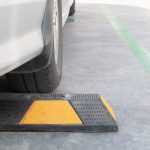Overview
Introduction to parking bumps
Parking bumps, also known as speed bumps or speed humps, are an essential feature in parking lots and residential areas. These raised structures are designed to slow down vehicles and ensure the safety of pedestrians and other drivers. However, parking bumps are not just functional; they also contribute to the overall aesthetics of the environment. With careful design and placement, parking bumps can seamlessly blend into the surrounding landscape, enhancing the visual appeal of the space. In this article, we will explore the importance of parking bumps in maintaining the balance between functionality and design, and how they can be incorporated into various architectural styles.
Importance of aesthetics in design
Aesthetics play a crucial role in design, as they enhance the overall experience and appeal of a product or space. When it comes to parking bumps, aesthetics are just as important as functionality. The design of parking bumps should not only serve their purpose of guiding vehicles and preventing accidents, but also blend seamlessly with the surrounding environment. By incorporating elements of design such as color, shape, and texture, parking bumps can become more visually pleasing and harmonious with their surroundings. This attention to aesthetics not only enhances the overall aesthetic value of parking lots, but also contributes to a safer and more enjoyable parking experience for users.
Purpose of the article
The purpose of the article, ‘The Aesthetics of parking lot bumps: Blending Functionality with Design’, is to explore the importance of incorporating aesthetics into the design of parking bumps. While parking bumps primarily serve a functional purpose of preventing vehicles from crossing into restricted areas, they can also contribute to the overall visual appeal of a parking lot or street. By blending functionality with design, parking bumps can enhance the overall aesthetics of the surrounding environment, creating a more pleasant and visually appealing experience for both drivers and pedestrians. This article aims to highlight the significance of considering aesthetics in the design of parking bumps and the potential benefits it can bring to urban spaces.
History of Parking Bumps
Early developments
Early developments in the field of parking bump design focused primarily on functionality rather than aesthetics. The main objective was to create a bump that effectively prevented vehicles from rolling forward or backward when parked. These early designs were often simple and utilitarian, consisting of a raised hump or barrier placed strategically in parking spaces. While these early developments were effective in fulfilling their intended purpose, they lacked any consideration for the visual appeal of parking bumps. As the field of design evolved, there was a growing recognition of the importance of aesthetics in all aspects of our built environment, including parking infrastructure. This led to a shift in focus towards blending functionality with design, giving rise to the concept of the aesthetics of parking bumps.
Evolution of parking bump designs
The Evolution of parking bump designs has seen significant changes over the years. Initially, parking bumps were simply functional, designed to prevent vehicles from rolling forward and damaging other cars or structures. However, as the importance of aesthetics in urban design grew, parking bump designs began to incorporate elements of style and visual appeal. Today, parking bumps are not just functional but also contribute to the overall aesthetic of parking lots and streets. They come in various shapes, sizes, and materials, allowing for customization and creativity. From simple concrete blocks to sleek and modern designs, parking bumps have evolved to blend functionality with design, enhancing both safety and visual appeal.
Impact of technology on parking bump aesthetics
With the advancement of technology, parking bump aesthetics have undergone significant transformations. The integration of technology has allowed for the development of innovative and visually appealing designs that not only serve their functional purpose but also enhance the overall aesthetics of parking areas. From LED lights embedded in parking bumps to smart sensors that detect the presence of vehicles, technology has revolutionized the way parking bumps are perceived. These technological advancements have not only improved the safety and efficiency of parking areas but have also added an element of sophistication and modernity to their design. The impact of technology on parking bump aesthetics is undeniable, as it has opened up new possibilities for creativity and has elevated the overall visual appeal of parking areas.
Functionality of Parking Bumps
Ensuring vehicle safety
Parking bumps play a crucial role in ensuring vehicle safety. These small yet effective barriers are strategically placed in parking lots to prevent vehicles from rolling forward or backward. By providing a physical obstacle, parking bumps help drivers park their vehicles securely and minimize the risk of accidents. Moreover, these bumps also serve as a visual indicator for drivers, guiding them to park within designated spaces. With their simple yet functional design, parking bumps blend functionality with aesthetics, creating a safer and more organized parking experience.
Preventing damage to property
Parking bumps, also known as speed bumps or speed humps, serve an important role in preventing damage to property. These raised structures are strategically placed in parking lots and driveways to slow down vehicles and ensure the safety of pedestrians and surrounding structures. By forcing drivers to reduce their speed, parking bumps help to minimize the risk of accidents and collisions. Additionally, they act as a visual deterrent, reminding drivers to be cautious and attentive while navigating through parking areas. The design of parking bumps is not only functional but also aesthetic, blending seamlessly with the surrounding environment. With their smooth curves and uniform appearance, these bumps add a touch of elegance to parking lots while serving their primary purpose of protecting property.
Guiding traffic flow
Parking bumps serve an important role in guiding traffic flow. By strategically placing these bumps in parking lots and garages, drivers are directed to follow a specific path, ensuring an organized and efficient flow of vehicles. Not only do parking bumps enhance safety by preventing speeding and reckless driving, but they also contribute to the overall aesthetics of the parking space. With careful consideration of their design and placement, parking bumps can seamlessly blend functionality with visual appeal, creating a harmonious environment for both drivers and pedestrians.
Design Principles for Parking Bumps
Integration with surrounding environment
Parking bumps play a crucial role in ensuring the smooth flow of traffic and maintaining safety in parking lots. However, their presence can sometimes disrupt the overall aesthetics of the surrounding environment. To address this issue, it is important to integrate parking bumps seamlessly with the surrounding landscape and design elements. This can be achieved by using materials and colors that blend harmoniously with the surroundings, such as using earth tones or natural textures. Additionally, incorporating green spaces or landscaping features around the parking bumps can help soften their visual impact and create a more visually pleasing environment. By carefully considering the integration of parking bumps with the surrounding environment, we can strike a balance between functionality and design, enhancing both the safety and visual appeal of parking areas.
Materials and colors
When it comes to materials and colors, parking bumps offer a variety of options to blend functionality with design. The choice of materials can range from durable rubber to concrete, depending on the intended purpose and aesthetic preference. Colors can be selected to complement the surrounding environment or to stand out for increased visibility. Whether it’s a subtle blend or a bold statement, the materials and colors of parking bumps can enhance the overall aesthetic appeal while serving their practical purpose.
Accessibility considerations
When considering the aesthetics of parking bumps, it is important to also take into account accessibility considerations. Parking bumps serve a functional purpose by delineating parking spaces and preventing vehicles from encroaching on pedestrian areas. However, it is crucial to ensure that these bumps do not create barriers for individuals with disabilities. Designing parking bumps with accessibility in mind can involve factors such as providing sufficient space for wheelchair users to maneuver, ensuring that the bumps are detectable by individuals with visual impairments, and maintaining a smooth and even surface to prevent tripping hazards. By blending functionality with design, parking bumps can not only enhance the overall aesthetics of a parking lot but also promote inclusivity and accessibility for all users.
Case Studies: Innovative Parking Bump Designs
Creative use of shapes and patterns
Parking bumps are often seen as mundane and utilitarian objects, serving the purpose of guiding vehicles and preventing accidents. However, there is a growing trend of incorporating creative shapes and patterns into these seemingly ordinary structures. By embracing aesthetics in parking bump design, cities and businesses are able to transform these functional elements into visually appealing features that enhance the overall ambiance of parking lots. From geometric patterns to abstract shapes, the creative use of shapes and patterns in parking bumps adds a touch of artistry to otherwise overlooked spaces. This innovative approach not only adds visual interest but also encourages a sense of playfulness and imagination, making parking lots more inviting and enjoyable for users. Whether it’s a vibrant color scheme or an intricate design, the creative use of shapes and patterns in parking bumps demonstrates the power of blending functionality with design, turning parking lots into unexpected canvases for artistic expression.
Incorporating art and cultural elements
Incorporating art and cultural elements into parking bump designs adds a unique and visually appealing touch to these otherwise mundane structures. By infusing elements of art, such as vibrant colors, intricate patterns, or symbolic motifs, parking bumps can become more than just functional barriers. They can transform into artistic installations that reflect the local culture and heritage, creating a sense of place and identity. Moreover, incorporating art into parking bump designs can also serve as a means of promoting local artists and their work, providing them with a platform to showcase their talent and creativity. This integration of art and cultural elements not only enhances the aesthetics of parking bumps but also contributes to the overall beautification and liveliness of the surrounding environment.
Smart parking bump technologies
Smart parking bump technologies are revolutionizing the way we approach parking. These innovative solutions combine functionality with design to enhance the overall parking experience. By incorporating advanced technologies such as sensors and cameras, smart parking bumps can detect the presence of vehicles and provide real-time information to drivers. This not only reduces the time spent searching for parking spaces but also improves safety and efficiency. Additionally, smart parking bumps can be customized to blend seamlessly with the surrounding environment, adding an aesthetic appeal to parking lots and streets. With the integration of smart parking bump technologies, parking becomes a seamless and visually pleasing experience.
Conclusion
The importance of aesthetics in parking bump design
Parking bumps may seem like a mundane and overlooked aspect of urban design, but their importance should not be underestimated. The aesthetics of parking bump design play a crucial role in creating a harmonious and visually appealing environment. While functionality and safety are primary concerns, incorporating aesthetic elements into parking bump design can enhance the overall experience for both drivers and pedestrians. A well-designed parking bump can contribute to the overall aesthetics of a parking lot or street, blending seamlessly with the surrounding architecture and landscape. By considering the aesthetics in parking bump design, cities can create a more welcoming and attractive space for residents and visitors alike.
Balancing functionality and visual appeal
When it comes to parking bumps, finding the perfect balance between functionality and visual appeal is crucial. While the primary purpose of parking bumps is to provide a physical barrier to prevent vehicles from encroaching into pedestrian areas, their design can also play a significant role in enhancing the overall aesthetics of a space. The challenge lies in creating a parking bump that not only serves its intended purpose but also seamlessly integrates with the surrounding environment. This requires careful consideration of factors such as size, shape, material, and color. By striking the right balance between functionality and visual appeal, parking bumps can not only ensure safety but also contribute to the overall design harmony of a parking area.
Future trends in parking bump aesthetics
As parking lots continue to evolve, so do the aesthetics of parking bumps. In recent years, there has been a growing emphasis on blending functionality with design when it comes to parking bump aesthetics. Future trends in parking bump aesthetics are expected to focus on creating visually appealing and innovative designs that not only serve their practical purpose but also enhance the overall aesthetic of parking lots. This includes incorporating elements such as unique shapes, vibrant colors, and even eco-friendly materials. With advancements in technology, we may also see the integration of smart features into parking bumps, such as sensors that can detect the presence of vehicles or LED lights that improve visibility at night. The future of parking bump aesthetics is exciting, promising a harmonious balance between functionality and visual appeal.




